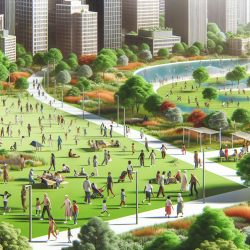Introduction
The COVID-19 pandemic has significantly altered many aspects of our daily lives, including how we interact with green infrastructure (GI). A recent scoping review titled "How the COVID-19 pandemic changed patterns of green infrastructure use" explores these changes, providing valuable insights into how the pandemic has influenced the use of parks, trails, and other green spaces. This blog will delve into the key findings of the review and discuss how practitioners can apply these insights to improve outcomes for children and communities.
Key Findings
The review highlights several important trends in GI use during the pandemic:
- Increased Use of Green Spaces: The pandemic led to a significant increase in the use of local green spaces as people sought safe outdoor environments for recreation and stress relief.
- Appreciation for Nature: Visitors' appreciation for the benefits of GI, such as stress reduction and physical health improvements, increased during the pandemic.
- Equity Concerns: The review identifies disparities in access to green spaces, with lower-income and minority communities having less access to these vital resources.
Implications for Practitioners
For practitioners, these findings underscore the importance of advocating for equitable access to green spaces, particularly in underserved communities. Here are some actionable steps practitioners can take:
- Promote Access to Local GI: Encourage the development and maintenance of local parks and green spaces to ensure all children have access to safe outdoor environments.
- Integrate Nature into Therapy: Incorporate outdoor activities and nature-based interventions into therapy sessions to leverage the mental and physical health benefits of GI.
- Advocate for Policy Change: Work with local governments and organizations to address disparities in GI access and promote the development of inclusive green spaces.
Encouraging Further Research
The review also highlights gaps in current research, suggesting opportunities for further study. Practitioners can contribute to this body of knowledge by conducting research on the long-term impacts of increased GI use during the pandemic and exploring innovative ways to integrate nature into therapeutic practices.
Conclusion
The COVID-19 pandemic has reshaped our relationship with green spaces, highlighting their importance for mental and physical well-being. By applying the insights from this review, practitioners can help ensure that all children have access to the benefits of nature, promoting healthier, more resilient communities.
To read the original research paper, please follow this link: How the COVID-19 pandemic changed patterns of green infrastructure use: A scoping review.










